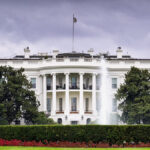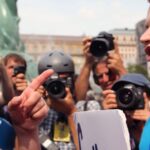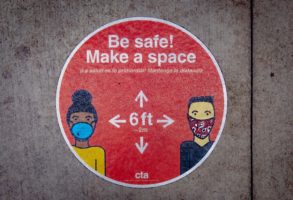Published November 3, 2022
The following essay was adapted from The New Abnormal: The Rise of the Biomedical Security State.
The biomedical security state that emerged during the COVID pandemic requires the power to monitor and control the movements and behaviors of an entire population, understood as a vector of disease, to manage a microbial threat. This necessitates mass surveillance facilitated by digital technologies—a level of intrusion incompatible with a free society.
In November 2021, Israel passed emergency pandemic legislation that permitted the Shin Bet, the nation’s equivalent of the CIA, to access mobile phones and extract track and trace data from suspected omicron patients without their consent. The New York Times quoted Limor Yehuda, a criminology professor supportive of this move, who remarked: “We have indeed reached a point at which we do need a ‘Big Brother’ keeping track of where we go.” He argued that this level of surveillance was necessary to quickly identify potential virus carriers who need to be tested and quarantined.
The Times also reported that pre-pandemic war-gaming exercises influenced Israel’s unprecedented actions during the pandemic:
In that exercise, senior officials simulated how they would respond to a fictional scenario that bore striking similarities to what is actually happening now. . . . In the simulation, officials . . . decided to keep Israel’s borders open to tourists into December, only to find that by the later stages of the exercise, the country’s hospitals were overwhelmed with patients. The correct decision, the participants concluded afterward, would have been to close Israel’s borders to most foreigners immediately, according to Yaacov Ayish, a retired general who helped plan the drill. ‘It was one of the lessons,’ Mr. Ayish said. ‘Suddenly, all the government agencies and the military had to analyze it as an option.’
We see in Israel’s response to the omicron variant all three basic characteristics of the biosecurity paradigm. First, measures are formulated based on possible risk in a hypothetical scenario, with data presented to promote behavior permitting management of an extreme situation. Typically, viruses tend to evolve by becoming more contagious but less deadly. This is because a virus “wants” to propagate but cannot do so if it kills too many hosts. It was therefore foreseeable that omicron would be less lethal than delta, yet Israel’s war-game scenario predicted that hospitals would be overwhelmed with cases from a new variant. This illustrates the second feature of the biosecurity paradigm: “worst case” logic is adopted as a key element of political rationality.
The third feature suggests that a systematic organization of the entire body of citizens is required to reinforce adherence to the institutions of government as much as possible. When the real omicron variant arrived, based on the biosecurity logic developed in Israel’s recent pandemic war-game simulation, Israeli legislators decided it was necessary to have their intelligence agency spy on their own citizens. This authoritarian invasion of privacy was done not because ordinary citizens were suspected of domestic terrorism, but because they might have been in contact with someone who had a virus that caused common-cold symptoms in almost all infected individuals.
Israel was not alone in this. In October 2021 the former privacy commissioner of Ontario, Ann Cavoukian, expressed concern that Canada’s vaccine passport system would amount to an intrusive surveillance regime that requires citizens to reveal private health information and tracks their movements. Two months later, Canada’s Public Health Agency confirmed it had indeed been tracking mobile phone data from the outset of the pandemic, covertly analyzing citizens’ movements to inform its pandemic response. The agency also revealed that it planned on expanding the program to other health issues and continuing it until 2026. Prime Minister Justin Trudeau had previously disavowed this strategy publicly back in March 2020. But his government did it nevertheless, without public notification or consent.
In May, Vice broke the story that during the previous two years the “CDC tracked millions of phones to see if Americans followed COVID lockdown orders.” According to documents obtained by Motherboard, the CDC used “phone location data to monitor schools and churches” and planned to also use the data for applications beyond COVID: “The documents also show that although the CDC used COVID-19 as a reason to buy access to the data more quickly, it intended to use it for more-general CDC purposes.” The recovered CDC documents, dating from 2021, state that the data “has been critical for ongoing response efforts, such as hourly monitoring of activity in curfew zones or detailed counts of visits to participating pharmacies for vaccine monitoring.”
“The documents contain a long list of what the CDC describes as 21 different ‘potential CDC use cases for the data.’” These include, among other applications, monitoring curfews, neighbor-to-neighbor visits, visits to churches and other places of worship, school visits, and “examination of the effectiveness of public policy on [the] Navajo Nation.” Other uses mentioned include public health issues besides COVID, such as “research points of interest for physical activity and chronic disease prevention such as visits to parks, gyms, or weight management businesses,” as well as “exposure to certain building types, urban areas, and violence.”
Better Late Than Never
Although the data purchased by the CDC was aggregated to show trends, “researchers have repeatedly raised concerns with how location data can be deanonymized and used to track specific people.” Research has demonstrated that unmasking specific users from these aggregated mobility datasets is quite feasible. One research team, for example, studied 15 months of human mobility data for 1.5 million individuals and published their results in Nature: “In a dataset where the location of an individual is specified hourly and with a spatial resolution equal to that given by the [mobile phone] carrier’s antennas, four spatio-temporal [data] points are enough to uniquely identify 95% of the individuals.” The researchers coarsened the spatio-temporal data and still found “even coarse datasets provide little anonymity.”
The CDC purchased its data from the controversial broker SafeGraph, a company that, according to CDC documents, offers data that “allows for extremely accurate insights related to age, gender, race, citizenship status, income, and more.” Due to its questionable practices, SafeGraph was banned from the Google Play Store in June 2021, which meant that “any app developers using SafeGraph’s code had to remove it from their apps.” The company includes among its key investors the former head of Saudi intelligence. This is where the CDC went to get its tracking data, paying SafeGraph $420,000 for access to one year of data.
Evidence also emerged recently that the CIA has been using unauthorized digital surveillance to spy on Americans. After supporting vaccine mandates in 2021, the ACLU finally took an interest again in civil liberties in 2022. They expressed alarm when newly declassified documents revealed that the CIA has been secretly conducting massive surveillance programs that capture Americans’ private information. Like the Shin Bet in Israel, our federal intelligence agency has been spying not on suspected terrorists but on ordinary Americans, with no judicial oversight and without congressional approval.
As the ACLU noted, “This surveillance is done without any court approval, and with few, if any, safeguards imposed by Congress to protect our civil liberties.” They argued: “These reports raise serious questions about what information of ours the CIA is vacuuming up in bulk and how the agency exploits that information to spy on Americans. This invasion of our privacy must stop.” Though the ACLU arrived a bit late to the party, as the old saying goes, better late than never.
Extralegal Developments
U.S. Senators Ron Wyden (D-Ore.), and Martin Heinrich (D-N.M.), both members of the Senate Intelligence Committee, called for the declassification and investigation of relevant CIA documents. In a letter of April 13, 2021, which they made public, the two senators expressed concern that the CIA program was
entirely outside the statutory framework that Congress and the public believe govern this collection [of data], and without any of the judicial, congressional or even executive branch oversight that comes from [Foreign Intelligence Surveillance Act—FISA] collection.
Despite Congress’s clear intent, with the support of the American people, to limit warrantless collection of Americans’ private records, the senators warn:
these documents reveal serious problems associated with warrantless backdoor searches of Americans, the same issue that has generated bipartisan concern in the FISA context.
There is a broader legal context for these extralegal developments of mass surveillance of civilian populations. Since the War on Terror began, Western nations have legislatively scaled up their increasingly intrusive networks of mass surveillance—often referred to with the euphemism “bulk collection.” The last decade has seen such measures passed in the United Kingdom, France, Australia, India, Sweden, and other countries—not to mention the AI-enabled facial- and gate-recognition surveillance in China, technology that Xi Jinping is already exporting to eager rogue regimes around the globe.
In the United States, even if Congress manages to rein in what appears to be the CIA’s extra-judicial activities—and we must hope that they do—this alone will not solve our surveillance problems. For in the contemporary context, mass surveillance can be conveniently crowdsourced. Social media groupthink and scapegoating enable citizens to surveil and punish one another in online environments. In The Crowdsourced Panopticon: Conformity and Control on Social Media, Jeremy Weissman makes the case that Twitter and other online platforms function in precisely this way.
Twitter mobs are a powerful social force that ideologues can manipulate to their advantage, particularly when Twitter and Facebook can put their thumbs on the scale by tweaking their algorithms. Some of us worry about government eavesdropping and corporate data harvesting; but in a more tangible way, most of us fear the public eye and its tools of social and professional censure. The societal effects of this may be far more consequential than anything dreamed up by CIA or NSA spooks.
Utilitarian Ethics
The implicit threat of cancellation or online public humiliation enforces tight social conformity. Online carrots and sticks can turn us into a kind of “personality machine,” in Weissman’s phrase, “emptied out and programmed by society, watching oneself do as society signals one to do.” In this digital environment, we “judge ourselves based on how others judge us on the screen, and act out the desired roles as directed accordingly.” The willingness of people to cancel relationships with friends and family over political differences or different views of COVID policies suggests the strength of these performative roles in shaping our identity. As many of us experienced in the last few years, while these tendencies have been developing for a decade, they accelerated dramatically during the pandemic.
Jeremy Bentham was an 18th-century philosopher and social reformer. Along with John Stuart Mill, Bentham is best known as one of the philosophical advocates of utilitarianism, the ethical theory that the ends do justify the means, so long as we aim at “the greatest happiness for the greatest number.” We can do bad things (for example, lie, steal, and cheat) if the overall outcomes result in an increase of overall happiness. This philosophy amounts to a kind of superstition according to which, by some mysterious mechanism, the deployment of sheer force automatically produces justice. Utilitarian “ethics” enjoyed a boon during the pandemic, but one of Bentham’s other contributions is even more relevant to our present moment.
Bentham pioneered what he called a “panopticon,” a blueprint for a system of surveilling and completely controlling a population. The floor plan involved a circular building with a guard at the center who could observe around the clock all the surrounding cells along the periphery. Although the design suggests a prison, Bentham maintained that the panopticon was “a new principle of construction applicable to any sort of establishment, in which persons of any description are to be kept under inspection.” Besides prisons, he also suggested its use in quarantine stations, poorhouses, houses of industry, factories, hospitals, workhouses, madhouses, and alas, schools.
The panopticon’s principle of radical transparency promised to rationalize the discipline of otherwise unruly populations. Because individuals could be observed at any moment—whether they were in fact observed or not—they would remain constantly on guard. Denizens inside the panopticon would self-police their behaviors and internalize the mechanisms of control. Through constant fear of punishment, prisoners would learn to patrol themselves. George Orwell captured this in his dystopian novel, Nineteen Eighty-Four, with his description of Big Brother’s ubiquitous television screens with built-in cameras, always on and always watching you: “You had to live—did live, from habit that became instinct—in the assumption that every sound you made was overheard, and, except in darkness, every movement scrutinized.”
The French philosopher Michel Foucault argued that the panopticon is not primarily a design for a building, but a metaphor for the exercise of political power in modern societies. In 1975, Foucault gave the following description in Discipline and Punish: “The Panopticon must not be understood as a dream building: it is the diagram of a mechanism of power reduced to its ideal form.” He goes on to explain, “It is in fact a figure of political technology that may and must be detached from any specific use.”
Worldwide Digital Panopticon
With the advent of technologies of mass surveillance, we now live in a kind of worldwide digital panopticon, where each citizen is simultaneously guard and fellow prisoner. In totalitarian societies one does not just fear the censure of the ruler, one fears everyone else, for every neighbor is a potential informant. Today, every potential informant is armed with a smartphone camera in his pocket. This means that the digital panopticon is more than just a metaphor: real people really are watching. Recall how university administrators encouraged students to act as informants during COVID to enforce strict compliance with the minutiae of their COVID protocols.
The power of our contemporary peer-to-peer crowdsourced panopticon is enhanced by novel technologies. Ray-Ban’s “smart glasses,” modeled on the Google Glass prototype, threaten to make invisible cameras omnipresent. The digital panopticon’s “data is stored online, almost never disappears, and is easily searchable. Information crosses the globe in the blink of an eye. The Stasi and KGB could only have dreamed of such a system.”
During the pandemic we reached a level of detailed behavioral scrutiny and social control—“pull your mask up over your nose”—never previously encountered in public social settings. Nobody wants to live in a house made entirely of glass with no way to pull down the shades. While a worldwide panopticon sounds to most people like a dystopian nightmare, many of our ruling technocrats hope to soon produce just such a society. For example, “former Google CEO Eric Schmidt dreams of a world where ‘everything is available, knowable, and recorded by everyone all the time.’” Meanwhile, “Airbnb founder Brian Chesky believes that a digitally enabled ‘reputation economy’ [that is, a social-credit system] will allow for ‘so many different activities that we can’t even imagine right now.’” As Professor Taylor Dotson shrewdly observed, “a radically transparent society also conveniently aligns with Silicon Valley’s dominant business model.”
The global digital panopticon discourages passionate commitments and encourages not just conformity, but a kind of conformity that’s easily manipulated by mass media or economic conglomerates. Don’t take risks, just pull that mask up and sanitize your hands again. If you refuse to comply, the consequences could be serious. We’ll look at just one example of the digital panopticon’s operation during the pandemic. A 2020 New Yorker essay told the story of Dr. Wojciech Rokita, a gynecologist and obstetrician in Poland, who served as a regional governmental health consultant during the pandemic.
Rokita had made significant contributions to public health during his career. Under his direction, the region’s neonatal mortality rate improved dramatically. In 2018, at the age of 52, “his peers elected him head of the Polish Society of Gynecologists and Obstetricians.” In March 2020, before Poland had any confirmed COVID cases, Rokita and his wife traveled to the Swiss Alps for a ski vacation. Worried about a new COVID outbreak in Switzerland, he headed home early and got tested. Poland shut its borders three days after he arrived home, but he tested positive.
A tabloid called Echo Dnia reported that the first patient in the region to test positive was a local doctor. Within a half hour of the article appearing online, Rokita was revealed in the comments section of the article. The storm of public vitriol commenced immediately: outraged comments flooded in, including from people who knew him personally, as the New Yorker reported:
“I’m certainly not going to let this go just because—thank God—I didn’t go to my appointment,” a hospital worker who was also a private patient of Rokita’s wrote, anonymously. “He could have consciously and deliberately infected me.” She added, “I wonder how many women weren’t as lucky as I was last week.” Video surveillance showed no sign of Rokita’s having been at the hospital before he started quarantining there. . . . A commenter on the Echo Dnia website said of Rokita, “Someone should spit in his face.” Another wrote, “If he went skiing during the epidemic, and he’s really a doctor, then I think he’s a brainless moron.”
The New Yorker reported that “Rokita’s cell phone was so overwhelmed by vitriolic calls that his family couldn’t get through to him. They began to worry that someone would burn down their house.” Rokita, who was quarantining in the hospital by his choice, called the newspaper and begged the paper to stop publishing the hateful comments. The editor responded that “limiting comments on the paper’s Facebook page” would only increase people’s anger. Rokita’s daughter Karolina told a reporter, “He was overwhelmed. Not only with the amount of hate comments, messages, phone calls he was receiving—even at 4 a.m.—but also with the fact that the attack came from people he knew and had helped in the past.”
A few days later, while still in the hospital, Rokita took his own life. The newspaper that had destroyed him was the first to report on his suicide, before his family was even informed. An online commentator quickly revealed that he had died by hanging. His daughter maintains his suicide was Rokita’s attempt to end the attacks his family was experiencing, as she explained: “The same way we were scared for him, he was scared for us.” No funeral home would accept his body. The hospital cremated his remains without the family’s consent. Hospital officials insisted that his family go to “a location outside the city limits to take possession of his ashes, as if he had been a medieval leper.”
Even after his death, the verbal attacks continued, with some commentators calling his suicide a “foolish overreaction.” Mimetic social censure and scapegoating are powerful forces, and online mob behaviors die hard.
The Public Health-Military-Intelligence-Industrial Complex
In addition to the Israeli generals who coordinated pandemic preparation drills, intelligence and other government agencies in the United States, in collaboration with public and private sector interests, have likewise been war-gaming pandemic scenarios for over two decades. The merging of public health and the military-intelligence-industrial complex did not begin with COVID. Public health’s gradual militarization is a decades-old development, massively accelerated by the COVID pandemic to be sure, but prepared by over 20 years of coordinated efforts.
Following the collapse of the Soviet Union in 1989, the military-industrial complex in the United States was casting about for a new enemy to keep its machinery operating and taxpayer capital flowing. Terrorism served this purpose for about 10 years after 2001, but over the past decade the industry found its foil in an old enemy that could be recast as a perennial and invisible threat: microbes—whether of natural or artificial origin. Like terrorism, viral and other microbial threats are, conveniently for those who stand to profit, an enemy that can never be fully vanquished.
In the decades before COVID, public and private institutional leaders in the United States ran several dry run tabletop simulations that anticipated and prepared our disastrous COVID response. In 1999 the U.S. Department of Health and Human Services, in collaboration with the newly formed Johns Hopkins Center for Civilian Biodefense Strategies (later renamed the Center for Health Security), hosted a simulation of a smallpox terrorist attack. Following the exercise, frontline medical teams recommended an increase in administrative state powers to impose quarantine, isolation, media censorship, and even the intervention of the military during a public health crisis.
Shortly afterwards U.S. lawmakers introduced these proposed recommendations, adding to them the empowering of local police and the National Guard during public health emergencies. In 2002 these were codified in federal law as the “U.S. Public Health Security & Bioterrorism Preparedness & Response Act.” The new law, which permitted quarantine, isolation, and censorship, applied not only to the sick but also to asymptomatic persons. While laws of this kind remain less common in Europe, a similar law was soon instituted in France.
Similar pandemic war-game scenarios continued for the next 15 years, complete with names straight out of central casting, including Dark Winter (2001), Atlantic Storm (2003, 2005), Global Mercury (2003), Lockstep (2010), Mars (2017), SPARS (2017), Clade X (2018), and Crimson Contagion (2019). Consistent themes included militarizing medicine and empowering centralized authoritarian governance capable of broad surveillance and behavioral control of large populations. Every one of these scenarios ended with coerced mass vaccination.
Each of these exercises predicted necessary futures that most ordinary people would find dystopian, but which the participants consistently described as “the new normal.” Robert F. Kennedy, Jr. summarized the common elements in all these pandemic war games: “The simulations war-gamed how to use police powers to detain and quarantine citizens, how to impose martial law, how to control messaging by deploying propaganda, how to employ censorship to silence dissent, and how to mandate masks, lockdowns, and coercive vaccinations and conduct track-and-trace surveillance among potentially reluctant populations.” The options that these scenarios never considered were just as significant as the solutions that they examined, as Kennedy also noted:
None of them emphasized protecting public health by showing Americans how to bolster their immune systems, to eat well, to lose weight, to exercise, to maintain vitamin D levels, and to avoid chemical exposure. None of these focused on devising the vital communications infrastructures to link frontline doctors during a pandemic or to facilitate the development and refinement of optimal treatment protocols. None of these dealt seriously with the need to identify off-the-shelf (now known as “repurposed”) therapeutic drugs to mitigate fatalities and to
shorten a pandemic’s duration. None of them considered ways to isolate the sick and protect the vulnerable—or how to shield people in nursing homes and other institutions from infection.
None of them questioned the efficacy of masks, lockdowns, and social distancing in reducing casualties. None of them engaged in soul-searching about how to preserve constitutional rights during a global pandemic.
This series of pandemic war games culminated in an astonishing simulation exercise, which preceded the first publicly reported case of COVID by only a few weeks. In October 2019, the renamed Johns Hopkins Center for Health Security, in partnership with the World Economic Forum and the Bill & Melinda Gates Foundation, organized a tabletop pandemic simulation scenario with epidemiologists and other experts called “Event 201: A Global Pandemic Exercise.” I recommend you watch this simulation online: the entire four-part event and a shorter 12-minute highlight version are available on YouTube. Participants included high-ranking individuals from the World Bank, the World Economic Forum, the Chinese government, the world’s largest pharmaceutical company (Johnson & Johnson), the CDC, a former NSA/CIA director, and Avril Haynes, later tapped by Biden to be the director of national intelligence—the highest-level intelligence official in the United States. Several of the participants in this simulation quickly moved into key positions to run our real COVID pandemic response only a few months later.
Life Imitates Art
I’ll mention a few highlights from the scripted scenario and tabletop discussion, where Bill Gates instructed participants to role-play as members of an international “Pandemic Control Council.” A new coronavirus (yes, you read that right) begins in pigs and spreads to humans, causing flu-like symptoms and pneumonia. Farmers start getting sick and the virus quickly spreads to become a global pandemic, with large numbers of people requiring intensive care and many dying. “There are problems emerging that can only be solved by global business and governments working together,” Tom Inglesby, director of the Johns Hopkins Center for Health Security, informs the council.
A news anchor on the fictional “GNN” network interrupts the discussion to inform participants that scientists are not optimistic about having a vaccine ready in time. Antivirals and other medical supplies are also in short supply, the news reports. Adrian Thomas of Johnson & Johnson testifies that a “global fund” that will serve as “a centralized mechanism capable of procuring pandemic supplies” is absolutely necessary. Count on the corporate executive at the table to pitch public funding for private enterprise.
Sofia Borges of the U.N. Foundation then asserts that the United Nations, of which the World Health Organization is a subsidiary, needs “a worldwide footprint” to help poorer countries during the pandemic. Christopher Elias from the Gates Foundation next argues that international organizations like the WHO must partner with private organizations (you might guess which ones) to facilitate an international stockpile of pandemic supplies like vaccines and “make smart decisions about how to allocate them to people who need them.” Then, in astonishingly telling remarks, Jane Halton of the ANZ Bank group explains not only the need to secure payments for the necessary supplies but also the need for governments to guarantee markets for their consumption:
So, to be completely clear, most of this production would already be completely committed in contracts. It is almost unheard of that people are producing product without having a forward commitment for the consumption of their product. So [this is] the first thing that needs to be done—because this is not something that countries control unless countries bring about emergency situations and co-opt an existing supply chain.
A note of realpolitik creeps in when Stephen Redd of the CDC worries that “countries are not going to buy countermeasures to put into a global supply without retaining a large portion of it for themselves.” GNN reporters again interrupt the roundtable discussion to update participants on the state of the pandemic: countries have banned travel from the worst-affected regions, and as a result “the travel and airline sectors are taking huge economic hits” with “a ripple effect racing through the tourist sector,” which eventually leads to a “growing global financial crisis.” The CDC’s Redd, outfitted in the uniform of a military officer, chimes in again and explains that to manage the financial crisis, “governments will need to be willing to do things that are out of their historical perspective; it’s really a war footing that we need to be on.”
The next GNN broadcast reports that countries are reacting in different ways regarding “how to handle dis- and mis-information” about the pandemic on the internet. “In some cases, limited internet shutdowns are being implemented to quell the panic.” Lavan Thiru, a monetary authority in Singapore, speculates that governments need to step up their suppression of “fake news,” and other participants opine on the need for “a technological answer to this.” Matthew Harrington of Edelman, the world’s leading corporate PR firm, then explains that social media companies cannot see themselves as technology platforms but as broadcasters, and “they in fact have to be a participant in broadcasting accurate information and partnering with the scientific and health communities to counterweight, if not flood the zone, of accurate information.” The people sitting around the table doubtless assume they will be the ones to determine what information is accurate.
The pandemic exercise culminates in a compulsory mass vaccination campaign, during which the council participants strategize about how to use censorship and other authoritarian measures to silence recalcitrant dissidents. Not to be outdone on this score, George Gao, director of the Chinese version of the CDC, worries about how to suppress inevitable rumors that the virus came from a lab: “People believe, ‘this is a man-made [pathogen]’ . . . and that some pharmaceutical company made the virus,” he complains during the council’s roundtable discussion. Two months later, Gao led the Chinese efforts to discredit the COVID lab-leak hypothesis. Life imitates art.
A narrator concludes Event 201 by informing us, “The outcome of [the scenario] was catastrophic. Sixty-five million people died in the first 18 months.” It’s instructive to note the alarmist language she employs throughout her closing monologue: “The outbreak was small at first and initially seemed controllable” but then spread worldwide to crowded mega-cities and spread became “explosive.” The narrator continued: “The global economy was in a freefall, the GDP down 11 percent, stock markets around the world plummeted between 20 and 40 percent and headed into a downward cycle of fear and low expectation,” she explains. The monologue continues, “Economists say the economic turmoil caused by such a pandemic will last for years, perhaps a decade. The societal impacts, the loss of faith in governments, the distrust of news, and the breakdown of social cohesion could last even longer.”
The narrator then explains that these catastrophic consequences could have been avoided with 10 years of proactive pandemic planning, utilizing the strategies advocated by the participants in the war-game exercise. She closes with the question, “So, are we as a global community now finally ready to do the hard work needed to prepare for the next pandemic?” Considering that Event 201 was staged a few weeks before anyone had heard of COVID, but while Wuhan was simultaneously seeing its first unreported cases of the novel pathogen, we must admit that this was quite a remarkable script. Event 201 did not arise from nowhere, as suggested by the list of previous pandemic war games given above.
It’s time for Congress to rein in the mass surveillance advanced by the biomedical security state, lest these developments in The New Abnormal become our permanent way of life.
Aaron Kheriaty is a physician, a fellow at the Ethics and Public Policy Center, and chief of ethics at The Unity Project.
Aaron Kheriaty, MD, is a Fellow & Director of the Program in Bioethics and American Democracy at the Ethics and Public Policy Center. He is a physician specializing in psychiatry and author of three books, including most recently, The New Abnormal: The Rise of the Biomedical Security State (2022).









